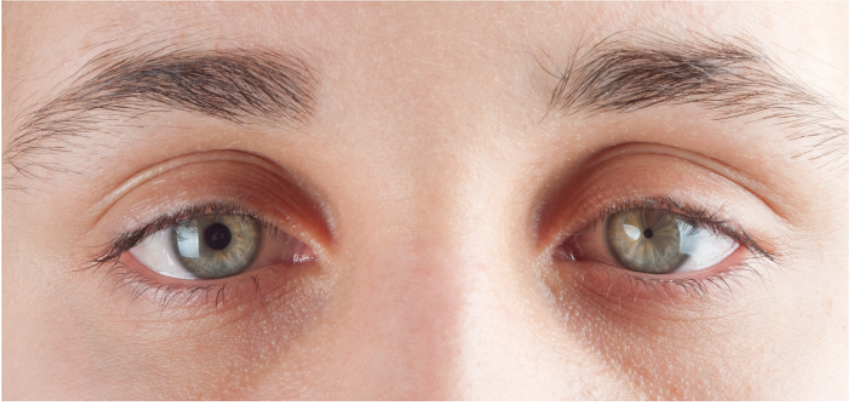Pinpoint pupils
SYMPTOMS
What are pinpoint pupils?
The pupil is a small black hole in the center of the eye, typically measuring between 2 to 5 millimeters in diameter.
When the pupil constricts to the size of a pinpoint under "normal lighting," it is referred to as "pinpoint pupils." In such cases, the pupil diameter is usually less than 2 millimeters, sometimes even smaller than 1 millimeter.
Pinpoint pupils may occur in both eyes or just one. When both eyes are affected, the pupil sizes may not be identical. As shown below:

What other symptoms typically accompany pinpoint pupils?
- Confusion or unconsciousness.
- Respiratory depression, leading to difficulty breathing.
- Nausea and vomiting.
- Drooping eyelid on one side and reduced facial sweating (seen in Horner's syndrome).
- Cold skin, pale complexion, slow heartbeat, and purple nails (often associated with opioid overdose).
- Red eyes and dry lips (commonly observed in cases of heavy heroin or other drug use).
What causes pinpoint pupils?
The pupil is part of the eye, primarily composed of contractile sphincter muscles that adjust its size to regulate the amount of light entering the eye.
In bright light, the pupil constricts to limit light exposure and reduce glare. In darkness, it dilates to gather more light for better vision.
Pupil size is controlled by two types of nerves: the sympathetic nerves (which dilate the pupil) and the parasympathetic nerves (which constrict it).
When drugs stimulate the parasympathetic system or the sympathetic nerves are damaged, the pupil may constrict excessively, resulting in pinpoint pupils.
Can pinpoint pupils occur in healthy individuals?
Yes, for example, in newborns around two weeks old. Their pupils are often very small or even pinpoint-sized to protect their delicate eyes from bright light.
Are pinpoint pupils life-threatening?
Conditions causing pinpoint pupils are usually serious and require urgent diagnosis and treatment.
In some cases, the pupillary light reflex (where the pupil changes size in response to light) remains intact, indicating a better prognosis.
However, patients with pinpoint pupils and absent light reflexes generally have a poorer prognosis.
TREATMENT
What treatments are available for pinpoint pupils?
When a patient exhibits unexplained pinpoint pupils, the most important action for witnesses or family members is to immediately transport them to the nearest hospital for emergency care.
Pinpoint pupils are ultimately just a symptom or manifestation, with many potential underlying causes. Further diagnostic tests in a hospital setting are necessary for accurate identification.
Additionally, family members can assist diagnosis by providing relevant medical history, including the patient's pre-existing conditions and behaviors prior to the episode.
After determining the cause, treatments for pinpoint pupils typically fall into the following categories:
- For cerebral hemorrhage patients: Surgical intervention is generally performed, along with strict blood pressure management. Doctors may initially maintain elevated blood pressure to ensure adequate cerebral perfusion, then gradually normalize it based on the patient's condition.
- For opioid overdose: Naloxone is typically administered to counteract opioid effects.
- For organophosphate pesticide poisoning: Gastric lavage may be performed if needed, along with neutralizing agents. Antidotes like pralidoxime are used for detoxification.
- For ocular inflammation: Corticosteroids (e.g., glucocorticoids) and topical ointments are commonly prescribed to restore normal pupil size.
DIAGNOSIS
Which department should I go to when pinpoint pupils appear?
Due to the acute onset, patients usually go to the emergency department first and are often later transferred to neurology.
What tests are needed when pinpoint pupils appear?
- Perform a head CT to check for brainstem hemorrhage.
- Draw blood for relevant blood tests to diagnose infections, etc.
POTENTIAL DISEASES
What is the most common cause of pinpoint pupils?
- Hemorrhagic stroke, commonly known as "stroke" or "cerebral hemorrhage." Pinpoint pupils are often seen in brainstem hemorrhage caused by poorly controlled hypertension.
- Opioid overdose, such as injecting large amounts of morphine.
What diseases or conditions are associated with pinpoint pupils?
- Brainstem lesions, such as bleeding caused by brain tumors, or brain herniation, cerebral edema due to other causes.
- Brainstem injury caused by traumatic brain injury.
- Horner's syndrome (cervical sympathetic nerve palsy syndrome).
- Poisoning or drug abuse, such as organophosphate pesticide poisoning or heavy heroin use.
- Drug overdose, such as ingesting large amounts of sleeping pills or injecting sedatives like morphine.
- Late-stage syphilis affecting the nervous system.
- Ocular diseases, such as infectious conditions like iritis.
- Use of certain pupil-constricting eye drops, such as those containing norepinephrine or pilocarpine.
- Rare genetic disorders causing autosomal abnormalities, leading to pupil abnormalities.
- Glaucoma in adolescents.
Can pinpoint pupils recover?
If the nerves themselves are not damaged and only temporarily compressed or irritated, the pupils will gradually return to normal size once the underlying cause is resolved.
If irreversible nerve damage occurs, the pupils may not return to their original state.
Will pinpoint pupils affect vision in the future?
Generally, if the cause is addressed promptly, there will be no impact on vision.